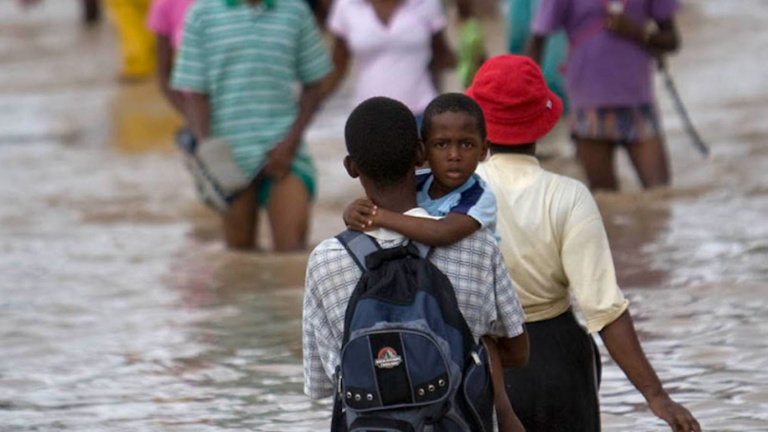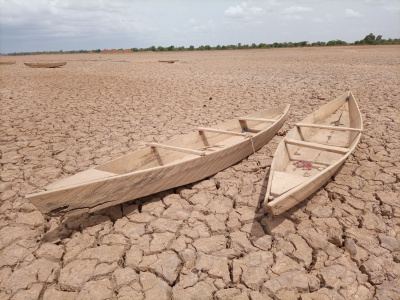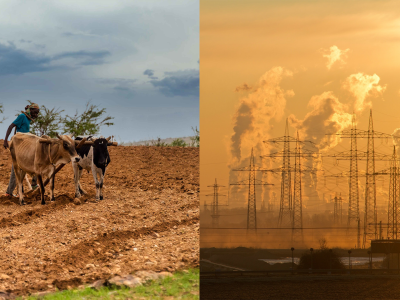
Keep climate change from fuelling conflict
As climate change advances, it is increasingly disrupting peace and security. This could mean a heightened risk of violent conflict for many already fragile countries with high exposure to climate hazards and limited coping capacity. New approaches are needed to work on the interlinkages between climate change, conflict prevention and sustaining peace.
The defining issue of our time
The Secretary-General of the United Nations has called climate change the defining issue of our time. Its impact today reaches far beyond the natural environment. Climate change is affecting human systems on a growing scale and is increasingly disrupting peace and security. The Armed Conflict Survey, published by the International Institute for Strategic Studies, this year for the first time included climate change in its overview of global trends affecting conflict. It states, “Climate change is a high-probability, high-impact security threat that will continue to accelerate over the coming decades, with a wide range of implications for the geostrategic environment.”
As highlighted in this edition, the changing climate can affect peace and security in different ways: while few experts claim that climate change causes conflict, there is growing consensus that it acts as a powerful “threat multiplier”, which interacts with a range of other factors to exacerbate the risk of conflict. By compounding existing stresses and strains, climate change can drive already fragile contexts closer to the edge.
The best defence: Strong institutions and good governance
Experiences of the United Nations throughout the world suggest that resilient states and societies, built on strong institutions and good governance, are the best defence against the adverse consequences of climate change. Ultimately, the ability to cope with the additional stresses imposed by climate change and to manage processes of transformation will largely determine the impact climate change has on human systems.
Recent research corroborates this view. According to the Global Peace Index (GPI) 2019, produced by the Institute for Economics and Peace, an estimated 971 million people live in areas with high or very high exposure to climate hazards. Of these, 400 million reside in countries with already low levels of ‘peacefulness’. The GPI sees a correlation between lower levels of “peacefulness” and lower capacity to cope with climate-related security risks. In other words, as climate change intensifies, a number of fragile countries are in danger of becoming stuck in a cycle of climate disaster and conflict.
That said, it would be wrong to think of climate-related security risks as a challenge reserved for the developing world. While greater exposure to climate impacts and more limited coping capacity indeed place many developing countries at higher risk, climate change could eventually bring chaos to the doorstep of all parts of the world. Just consider the knock-on effects of forced displacement and interrupted global supply chains, or the challenge of devising energy transition policies that are seen to potentially threaten domestic and international balance of powers.
In the face of these complex interlinkages between climate change, conflict prevention and sustaining peace, there is a growing expectation that the United Nations must take a leadership role in developing multidimensional strategies for responses. This is a relatively new work stream for us, with four immediate areas of focus.
Research, documentation and analysis
Scientists are still debating the causal associations between climate change and peace and security on the basis of quantitative data. This is important work, but by the time definitive conclusions emerge it may already be too late to act. What is missing right now – where there is a real gap – is good qualitative research to advance our understanding of the pathways through which climate change impacts peace and security in particular contexts. Identifying such pathways is a challenge in itself. The effects of climate change are highly contextual and manifest very differently in the Sahel versus the Pacific. They also have wildly varying time horizons; think of rapid-onset floods and cyclones versus slow-onset sea level rise. This poses a challenge both for analyses and for operational responses.
The global evidence base on climate-related security impacts is patchy; we urgently need to build it up. This will help us better understand why similar climate exposure leads to different consequences in different communities. What are the pathways through which climate hazards interact with social, economic, demographic and political factors? What and where are the greatest risks? What are the most effective coping capacities employed by communities and societies? Arguably most importantly, what response strategies have worked – and not worked – so far?
Make peace and security work more climate-informed
Climate risk assessments must inform the full range of peace and security activities, from analysis to conflict prevention initiatives, mediation strategies, peacebuilding priority plans and the footprint of multilateral peace operations. At the same time, climate adaptation strategies must be made more conflict sensitive and mitigation policies considered, taking into account their wider impacts on society. Collectively, the world mobilises hundreds of billions of dollars each year to respond to climate change. If this money is not spent wisely, it can do more harm than good.
Across the UN system, many entities work on climate, the environment, disaster risk reduction and sustainable development. Many others work on peace and security and the prevention of deadly conflict. What is urgent now is to mobilise capacity throughout the United Nations to work precisely at the intersection of these different fields, and to address climate-related security risks collectively at multiple levels.
To jumpstart this work and leverage existing capabilities and expertise, we have established a small inter-agency mechanism between the UN Department of Political and Peacebuilding Affairs (UNDPPA), the UN Development Programme (UNDP) and UN Environment. That mechanism is beginning to gain traction, working with partners across and beyond the organisation. But this is just a start. Much more needs to be done, in a much broader coalition.
Forge partnerships
Just as climate change is too big a challenge to be addressed by a single entity, its impacts on peace and security exceed the managing capacity of any individual actor. To be even moderately successful in addressing climate-related security risks, the United Nations needs to form strategic partnerships with different actors. These include regional organisations such as the European Union, the African Union and the Pacific Islands Forum, which are very active in this area. We must also invest in learning from the private sector. Many insurance companies already undertake expert climate-related security risk analysis. Academic institutions and think tanks with the capacity to conduct cutting edge research in this hitherto niche field are important partners as well. They offer the possibility of combining their scientific research with our practitioner perspectives, data and qualitative findings from the Sahel, the Horn of Africa, the broader Middle East, the Pacific and elsewhere.
Develop management strategies and – eventually – prevention strategies
Climate change affects many areas at once and does not fit neatly into a traditional response framework. It has been called a hard security problem with no hard security solutions. Its complexity poses a challenge not just for understanding how climate change impacts peace and security, but also for discerning what to do about it. The UN Security Council in a number of recent resolutions has called on the UN system to assist the Lake Chad region, Mali, the Central African Republic, Darfur and Somalia in developing strategies to manage the adverse effects of climate change on stability. This is hard to do and hard to get right. Even harder is to design prevention strategies that can stop adverse effects from worsening in the future. Being helpful to member states in this area is very much an aspiration, as we seek to collect data, distil experiences and understand more about which strategies and approaches work and which do not. But this is the direction we collectively need to go.
Conclusion
The world has never before sought to deliver peace and security in a climate-changed environment, and there is no roadmap. Clearly, the most viable solution long term is ambitious climate action, beginning with full implementation of the Paris Agreement. But in the meantime, as climate change advances, its repercussions will continue to grow, including on peace and security. We need to know more, and do more, now, to help guide the new approaches necessary for work on the interlinkages of climate change, conflict prevention and sustaining peace.
About the authors
Alexandra Pichler Fong and Helena de Jong work in the Policy and Mediation Division of the Department of Political and Peacebuilding Affairs, UN Headquarters, New York. The views expressed in this article are those of the authors and do not necessarily reflect those of the United Nations. Email: alexandra.fong@un.org
Read the full magazine issue









